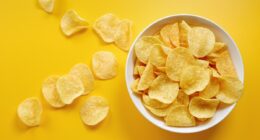
It’s a lot to take in, and an easier way to conceptualize the change is probably to look at which foods would be added to the “healthy” list and which ones would be taken off of it. “Avocados, certain oils, nuts and seeds, water and higher fat fish like salmon, would meet the newly proposed criteria for ‘healthy’ whereas they don’t meet the criteria of the current definition,” Kris Sollid, RD, senior director of nutrition communications at the International Food Information Council, tells SELF. “Products that meet the existing ‘healthy’ criteria but wouldn’t now, according to the proposed definition, include white bread and sweetened cereals and yogurts that exceed limits on added sugars.”
One problem with this new definition is that individual foods don’t really make or break our health.
Implying that certain foods are healthy while others aren’t is reductive, to put it mildly. Even the dietary guidelines, on which this new rule is based, make clear that it’s a person’s overall diet that impacts their health, not each and every food choice.
“Ultimately, the FDA wants to empower consumers to make food decisions that are ‘healthy,’ but they are missing the mark,” Samina Qureshi, RDN, a Houston-based dietitian and the owner of Wholesome Start Nutrition Counseling, tells SELF. Saying that some foods are healthy while others aren’t is far too black and white, Qureshi says.
For example, white bread (which wouldn’t be considered healthy under the new definition) could be part of a balanced meal if it’s paired with a variety of nutritious sandwich fillings like turkey, cheese, avocado, and tomatoes. On the flip side, if someone eats just plain yogurt (considered healthy) as a meal, they’re not getting the same variety of nutrients. But that’s perfectly OK too—you don’t necessarily need a variety of nutrients in every meal or snack. Again, a “balanced” diet is about the big picture: eating different foods and enough food overall.
READ RELATED: Babies born in lockdown were less likely to have said their first word by the time they turned one
Plus, what’s healthy for one person isn’t necessarily healthy for another.
Maggie Landes, MD, MPH, a pediatrician based in Killeen, Texas, and host of the Health Can’t Weight podcast, tells SELF that health has different meanings to different people, and that what’s healthy for one person isn’t necessarily healthy for another.
Qureshi agrees. “Just because a can of low-sodium beans is labeled ‘healthy’ doesn’t mean that someone with IBS can sit there and eat the whole can of beans without aggravating their digestive symptoms,” she says. “The same goes for someone with poor blood sugar regulation—they also wouldn’t be able to eat a whole can of low-sodium black beans without it impacting their blood sugar and insulin levels.”
There’s also the fact that focusing too much on “healthy” eating can be unhealthy. “If someone struggles with their relationship with food and sees this new ‘healthy’ label, they may get stuck in the rigidity of what the label means and think those are the only foods they are able to consume,” Qureshi says. “The new ‘healthy’ label and definition lack the nuance necessary for people to better care for their health in a gentle, culturally relevant, and balanced way.”
Source: SELF








